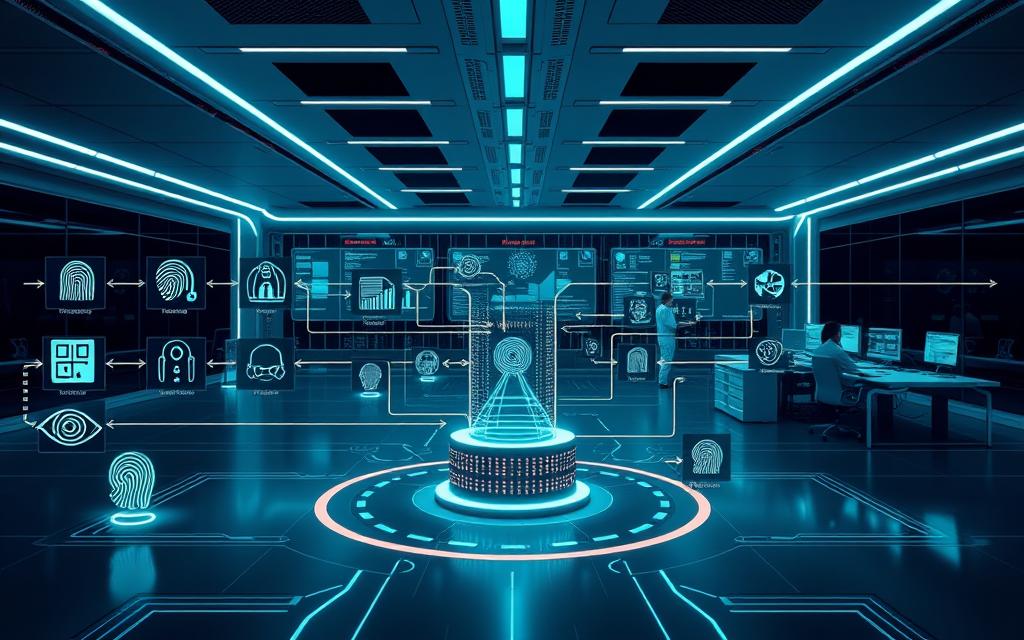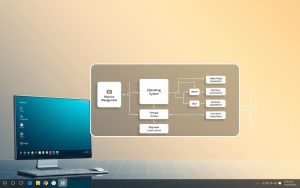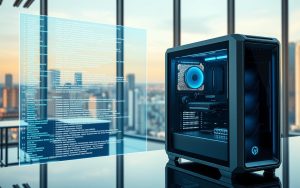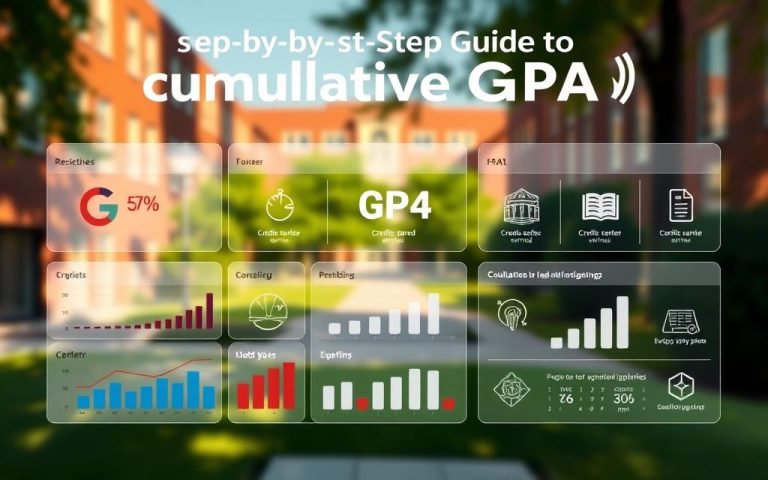Understanding Biometric Systems in Computers
Biometric systems are revolutionising computer security. They analyse unique physical and behavioural traits to verify identities1. This advanced authentication technology replaces traditional passwords, boosting security and convenience1.
Modern computer security heavily relies on biometric systems. These systems use facial recognition, fingerprints, iris scans, and voice recognition1. Artificial intelligence and machine learning have greatly improved their accuracy1.
Organisations worldwide are embracing these innovative authentication technologies. Biometric tech is transforming digital identification in various sectors1. There’s a growing trend of using biometrics in law enforcement, government, healthcare, and airport security1.
However, challenges persist in implementing biometric systems. These include data privacy concerns, high costs, and potential capture errors1. Yet, ongoing development of sophisticated authentication methods continues to drive innovation in computer security.
Types of Biometric Authentication Methods
Biometric authentication uses unique human traits for identity verification. It’s a sophisticated approach to digital security across various tech platforms. These systems fall into two main groups: physiological and behavioural biometrics2.
Physiological Biometric Technologies
Physiological biometrics measure physical traits that uniquely identify individuals. Fingerprint recognition is the most common authentication tech, securing devices, cars, and buildings2.
This method offers robust protection. The chance of two fingerprints matching exactly is 1 in 64 billion2.
- Facial recognition technology
- Iris scanning systems
- Vein pattern authentication
Some physiological biometrics are remarkably accurate. Iris recognition boasts a 99.59% accuracy rate3. Vein biometrics have a low false rejection rate of less than 0.00008%3.
Behavioural Biometric Approaches
Behavioural biometrics analyse unique patterns in human activity. Keystroke dynamics and voice recognition offer continuous authentication methods. These track individual interaction patterns.
Voice recognition tech focuses on mouth and throat shape. This helps distinguish unique voiceprints4.
| Biometric Type | Authentication Characteristic | Typical Application |
|---|---|---|
| Fingerprint Recognition | Physical Patterns | Mobile Device Security |
| Voice Recognition | Sound Patterns | Call Centre Authentication |
| Keystroke Dynamics | Typing Rhythm | Continuous Computer Access |
About 75% of people are comfortable using biometric authentication3. These technologies continue to revolutionise digital security across various sectors.
How Biometric Systems Process Data
Biometric data processing uses unique personal traits for secure digital authentication. These systems turn biological info into precise digital profiles. This enables robust security across various tech platforms5.

The biometric data processing journey involves several critical stages. These ensure accurate and secure identification. Let’s explore these stages in detail.
- Data Capture: Collecting raw biometric input using specialised scanners5
- Feature Extraction: Identifying unique characteristics from captured data6
- Template Creation: Converting extracted features into digital templates5
- Matching: Comparing live data against stored templates5
- Decision Making: Determining authentication status
Template Creation and Storage
Modern biometric matching algorithms use a nuanced template creation process. Systems typically convert biometric traits into encoded digital representations. This approach enhances privacy and reduces storage needs56.
Matching and Decision Making
Biometric matching algorithms use advanced techniques to compare data with stored templates. The process involves precise maths, measuring similarity through complex computational methods5.
| Performance Metric | Description | Significance |
|---|---|---|
| False Acceptance Rate (FAR) | Probability of incorrectly accepting unauthorized users | Security indicator |
| False Rejection Rate (FRR) | Probability of incorrectly rejecting legitimate users | User experience indicator |
| Equal Error Rate (EER) | Point where FAR and FRR intersect | Overall system performance metric |
“Biometric authentication transforms complex personal characteristics into precise digital signatures, revolutionising security paradigms.”
Security pros constantly improve biometric matching algorithms. They aim to balance strict security with user-friendly experiences6. By fine-tuning decision thresholds, these systems adapt to various authentication scenarios5.
Applications of Biometric Systems in Modern Computing
Biometric systems have transformed security and authentication across many sectors7. These advanced technologies enable sophisticated access control mechanisms. They go far beyond traditional security methods8.
Enterprise Security Strategies
Modern enterprises are using mobile biometrics to strengthen their security. Key applications include:
- Physical access control using fingerprint and facial recognition7
- Secure computer login systems9
- Employee verification processes8
Mobile Device Authentication
Smartphones now use advanced biometric tech for secure user experiences. These mobile biometrics include:
Financial Technology Integration
Fintech security has improved through biometric authentication. Banks and financial institutions are using tech that enables:
Biometric systems can compare hundreds of millions of data points in less than one second, providing unprecedented security and efficiency8.
Biometric tech keeps evolving, reshaping security across industries. It offers robust, innovative solutions for authentication and access control.
Challenges and Considerations in Biometric Systems
Biometric technologies pose complex challenges that need careful examination. Privacy and data security are top concerns in digital identification. These issues significantly affect biometric system development, with 58% seeing them as critical market barriers10.
Nearly 41% of survey participants don’t trust corporations to manage biometric data responsibly10. The reliability of biometric systems adds further complications. False positives can compromise security protocols, challenging trust in these solutions11.
Biometric systems use probabilistic matching, which can lead to verification errors11. Surprisingly, 62% of users aren’t deterred by potential technological risks10. This suggests a growing acceptance of biometric authentication.
Ethical concerns about biometric data security require strong legal frameworks. States like Illinois and California have strict rules to protect individual privacy. Meta’s $1.4 billion settlement for unauthorised data capture highlights the legal consequences10.
Civil liberties groups advocate for responsible use and strict oversight of biometric technologies. Future developments must balance privacy, accuracy, and ethical use. Ongoing research aims to address limitations while maintaining the benefits of these technologies.
FAQ
What are biometric systems in computers?
How do physiological biometric methods differ from behavioural biometrics?
What steps are involved in biometric data processing?
Where are biometric systems currently being used?
What are the primary privacy concerns with biometric systems?
How accurate are biometric authentication methods?
Can biometric data be hacked or replicated?
What emerging biometric technologies should we expect in the future?
Source Links
- https://www.techtarget.com/searchsecurity/definition/biometrics
- https://www.logintc.com/types-of-authentication/biometric-authentication/
- https://www.abiresearch.com/blog/types-of-biometrics
- https://www.spiceworks.com/it-security/identity-access-management/articles/what-is-biometric-authentication-definition-benefits-tools/
- https://www.vision-box.com/blog/components-biometric-systems
- https://www.miteksystems.com/blog/advantages-and-disadvantages-of-biometrics
- https://www.aware.com/what-are-biometrics-biometric-applications/
- https://www.innovatrics.com/glossary/biometric-system/
- https://www.techtarget.com/searchsecurity/definition/biometric-authentication
- https://www.techtarget.com/searchsecurity/tip/In-biometrics-security-concerns-span-technical-legal-and-ethical
- https://ovic.vic.gov.au/privacy/resources-for-organisations/biometrics-and-privacy-issues-and-challenges/













